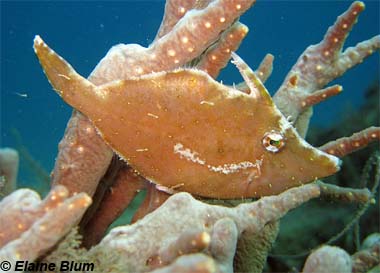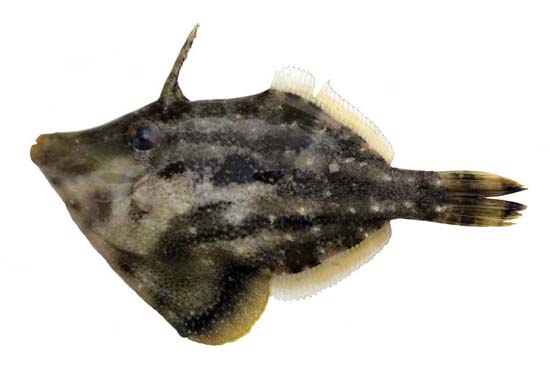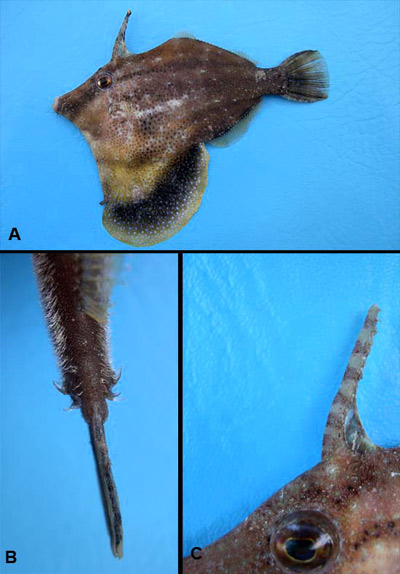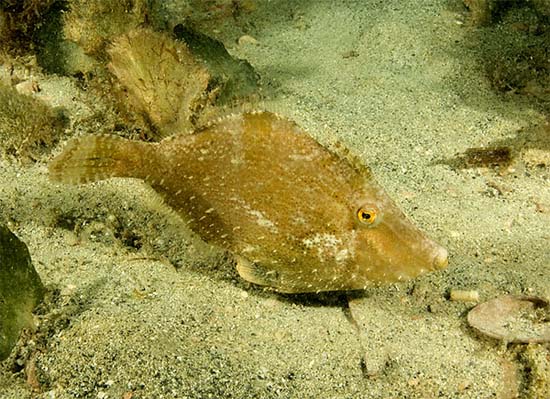Fringed Filefish

Monacanthus ciliatus
Filefish are flat oval-shaped fish that can escape predators by hiding in a crevice and extending the spines at the top of their heads to firmly wedge themselves into the space. The fringed filefish has an extendable “dewlap” under its belly that makes it appear larger if needed. They prefer to float head down in shallow seagrass beds as camouflage, and eat algae and small invertebrates, growing to about 4 inches long, but rarely more than 8 inches. Not a common food fish, they should be handled with care because of the long spines the males have on either side of their tails.
Order – Tetraodontiformes
Family – Monacanthidae
Genus – Monacanthus
Species – ciliatus
Common Names
English language common names are fringed filefish, cuckold, and leather-fish. Other common names include bourse émeri (French), cangulo (Portuguese), cangulo-de-fernando (Portuguese), chivo (Spanish), cholita de limo (Spanish), jednokolec zmienny (Polish), lija de clavo (Spanish), peixe-porco (Portuguese), peruá (Portuguese), piraaca (Portuguese), pirá-aca (Portuguese), pishiporko (Papiamento), sobaco común (Spanish), and uchiwahagi (Japanese).
Importance to Humans

Filefish are of little importance as a food fish due to its rare consumption and implication in ciguatera poisoning. However, it is a popular snack food in Korea where it is typically dried and processed into a sweet and salty jerky which is then roasted prior to consumption.
Conservation
The fringed filefish is not listed as endangered or vulnerable with the World Conservation Union (IUCN). The IUCN is a global union of states, governmental agencies, and non-governmental organizations in a partnership that assesses the conservation status of species.
> Check the status of the fringed filefish at the IUCN website.
Geographical Distribution

The fringed filefish is found in the western Atlantic Ocean from Newfoundland Canada south to Bermuda and the northern Gulf of Mexico, and then on to Argentina including the Caribbean region.
Habitat
Most commonly observed moving among seagrass with its head down, the fringed filefish also resides over shallow sandy and rock bottoms to depths of 165 feet (50 m). Filefish are not great swimmers due to their small fins. They often drift head down among the stands of seaweed to camouflage, fooling both prey and predators alike. When filefish feel threatened, they retreat to the protection of crevices within the reef. Young fringed filefish often associated with floating sargassum.
Biology

Distinctive Features
Filefish are uniquely shaped with deeply keeled bodies and prominently projecting snouts, with small pectoral fins and truncated, fan-shaped caudal fins. There is a slender, retractable spine that crowns the head, just above the posterior portion of the eye. The mouth is small and terminal, containing specialized incisors on the upper and lower jaws. In addition, the upper jaw has four teeth in an inner series and six in the outer series while in the lower jaw there are four to six in the outer series. The eyes are positioned high on the head and although filefish have scales, they are so small that they appear to be scaleless. Adult male fringed filefish have two pairs of enlarged recurved spines on each side of the caudal peduncle while the spines of female specimens are only slightly larger than the other scale spines of the caudal peduncle. The greatly elongated pelvic bones create a “dewlap” of skin between the bone’s keeled termination and the belly – these bones along with other bones of the pelvic girdle are capable of moving up and down to form a large dewlap effectively used to make the fish appear much deeper in the body than reality.
Coloration
Fringed filefish vary in color from olive gray or green to yellowish brown along with darker blotches and bands. The dorsal and anal fins of this species are pinkish, usually with three dark spots at the base. The caudal fin is greenish with mottling. The ventral dewlap is edged in scarlet.
Dentition
The mouth is small and terminal, containing specialized incisors on the upper and lower jaws. In addition, the upper jaw has four teeth in an inner series and six in the outer series while in the lower jaw there are four to six in the outer series.
Size, Age, and Growth
The maximum reported length of the fringed filefish is 8 inches (20.0 cm) total length (TL), however this species is more commonly observed at 4 inches (10.0 cm) TL.

Food Habits
Fringed filefish feed on plants and algae as well as small invertebrates including amphipods, isopods, ostracods, polychaetes, bivalves, shrimp, and spongestes.Reproduction
Filefish breed in groups consisting of one male and two to five females. The females lay demersal eggs in safe areas such as a depression in the sand, then the male comes along and fertilizes them. The male or female will guard these fertilized eggs from predators and will attack any intruders that approach too closely.
Predators
Larger fish are potential predators of the fringed filefish including dolphinfish (Coryphaena hippurus) and tuna (Thunnus albacares).
Taxonomy
The fringed filefish was originally described as Balistes ciliatus by Mitchill in 1818, however this was later changed to the currently valid scientific name Monacanthus ciliatus Mitchill 1818. Synonyms referring to this species includeMonacanthus davidsonii Cope 1871, Monacanthus occidentalis Günther 1870, and Monacanthus piraaca Kner 1867. Monacanthidae, a family of filefish, consists of 107 species within 26 genera which are all closely related to triggerfish, pufferfish, and trunkfish. The genus name Monacanthus is derived from the Greek monos meaning “one and akantha meaning “thorn” referring to the retractable spine located on the top of the head.
Prepared by: Cathleen Bester